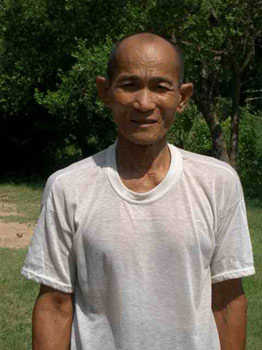The Cambodia Rural School Project
The O Svay Nippon Foundation
School

Lay Cheng, a 71-year old farmer with ten grandchildren attending
the O Svay Nippon Foundation School.
Lay Cheng is a 71-year old farmer living 500 meters away from the school. He lives with his wife and has seven children, all of whom have families of their own. All live in the school village. He currently has ten grandchildren who attend the school. They walk here everyday.
“My family farms for a living. We grow rice during the dry season, and run a small business selling and exchanging goods in between.”
“I wasn’t very happy when there was only the old building. Teachers weren’t happy. There weren’t any walls or desks to keep the rain and sunlight out. Some students even traveled all the way across the river to attend another school. Now that we have the new building, the teachers are more motivated to teach and the villagers are happier. Solar panels were installed just about a year ago. We still get excited about the new school because we’ve never received anything like this before. There is no big lack of teachers yet, but there probably will be within the upcoming months.”
“Ever since the school was constructed, I’ve never forgotten that this school was able to be built because of the kindness of those abroad. I would like to thank the donors for doing this. Now there are actual roads that run through the village, and people can get to the schools. It would be wonderful if they could continue to help us because we lack a lot. For example, we tried to do a fundraiser to build a fence for the school, but this village is so poor that it wasn’t possible. We only managed to gather enough for a front gate, but there is no fence. The villagers here have the heart and energy to build the fence, but no funds for the materials, which is a shame.”

